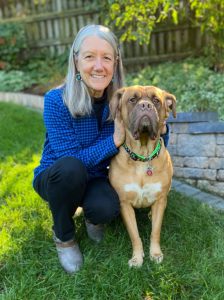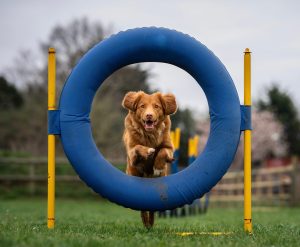
TERRY LACKMEYER
Customer Service Representative

No matter what activity or sport you want to engage in with your dog, it is important that your dog have a good command of basic obedience skills. They should know “Heel,” “Sit,” “Down,” “Stay,” “Stand,” and have a strong, reliable “Come.” This means they come to you without hesitation when called – no matter what! Once you have those basics conquered, the realm of dog activities you can pursue is wide open. Let’s look at some of those activities.
Canine Good Citizen Certification
Once your dog has mastered obedience skills, they can be tested and awarded their CGC certificate upon passing. The test encompasses not only obedience skill performance, but also your dog’s ability to maneuver gracefully and calmly through crowds, behave in the presence of other dogs, accept interaction from strangers, and tolerate being left alone with a stranger. Having this certificate is often a prerequisite for therapy dog certification and is a great door opener to other canine sports and activities. Some homeowners’ insurance companies even offer discounts if your dog has this certification.
Dog Obedience Competition
Obedience competitions allow you to show off your dog’s training and win awards for their knowledge. These are judged competitions with very specific rules and regulations. The dog/handler team does not perform any skill until instructed by the judge. There are three levels of competition starting with Novice, then Open, and finally Utility. The dog must pass the lower level of performance before progressing to the higher level.
Rally Obedience
This type of obedience competition is more relaxed and less rigid than traditional obedience competition. The dog works in a heel position with the handler progressing through a prescribed course where the skills to be performed are indicated with the use of 10-20 different signs. It is a timed course and the team that completes the course with the best time and fewest faults is the winner.
Agility
This is a competitive sport in which dog and handler work together to navigate a predetermined obstacle course of jumps, tunnels, and walkways while racing against the clock. The dog runs the course while being directed by the handler. This is a sport in which command of obedience skills is paramount as the dog is directed with voice commands, hand signals, and body language as to which obstacle to navigate. This sport offers excellent mental stimulation as well as exercise. While all dogs may not excel in competition, most dogs tend to love the activity and it is a great way to bond with your dog. There are agility clubs throughout the country and even if you don’t want to compete you still can enjoy working with your dog in this sport.
Freestyle Dance
Freestyle is a choreographed performance in which dog and handler together perform various maneuvers set to music. Like agility, this is a great way to provide mental stimulation in conjunction with exercise. Again, this sport requires a firm command of obedience skills, especially the “Heel” command. The dog first learns each individual maneuver, then the moves are combined and set to music to create the dance. Just about anything is allowed provided it doesn’t endanger dog or handler. This type of activity also provides the handler with the ability to be creative not only through the routine but also with the creation of costumes for themselves and their dog.
Disc Catching
This sport engages a dog in catching a round disc, much like a Frisbee, for fun and competition. Any breed of dog that loves to run and catch items tends to excel at this sport. High energy dogs such as border collies, Australian shepherds, and Jack Russell’s tend to be particularly good at this. This is a great sport for burning off excess energy. While there are competitions in which your dog can compete in this sport, the great part about disc catching is that it can be done in your own backyard, or any open flat area.
Flyball
This is a great activity for dogs with high energy and a love for balls. It is a relay race that involves a team of four dogs. The first dog runs a straightaway, jumping over a series of several hurdles. After the last hurdle, they trigger a lever that releases a tennis ball which the dog catches. Carrying the tennis ball, the dog returns over the same hurdles to the starting point. The next dog then completes the same course, including catching the ball released by the lever. This pattern continues until all four dogs have completed the course. While certain breeds tend to excel at this sport, it is a good sport for any dog that loves running and balls.
Dock Jumping
High energy dogs that love water tend to excel at this sport – think any of the retrievers. The dog jumps from a dock into a body of water attempting to jump as far or as high as possible. There are currently two versions of this sport. Distance jumping is the version with which most people are familiar. A bumper is thrown from the dock, attempting to get the dog to jump as far from the dock as possible. The second version is a vertical jump, sometimes referred to as ultimate vertical or extreme vertical dock diving. A bumper is suspended in the air at a predetermined spot from the dock. The goal is for the dog to grab the bumper as they jump from the dock. The height of the bumper continues to increase each time the dog jumps. The winner is the dog that reaches the bumper at its highest point.
Lure Coursing
This sport is particularly good for sight hounds such as greyhounds, whippets, and salukis. In this replacement for hare coursing, the dog chases an artificial lure over a course that sometimes involves obstacles. The dog with the best time is declared the winner.
Herding
Most dogs from the herding group possess the innate ability to herd. This includes such breeds as border collies, collies, Shetland sheepdogs, and Australian shepherds to name a few. Sometimes, even dogs that you wouldn’t consider seem to have a natural ability for herding. Those dogs that have this ability really seem to love the sport when exposed to the opportunity. Since many dogs live in cities and suburbs, finding the opportunity to engage in this sport may be challenging. However, an internet search should put you in contact with training clubs in your area. If your dog excels at this, you eventually may want to enter competitions.
Scent Tracking
We all know dogs have great noses, but some are particularly talented when it comes to following scents. Scent tracking is a great way to let your dog really enjoy their innate talent. A human scent track is laid, encompassing twists and turns and sometimes obstacles, and the dog is required to follow this track to find the human waiting at the end. Like the other sports, those dogs that truly enjoy and excel at this can get involved in competitions.
Altruistic Endeavors – Therapy Work
For many dogs, their best reward is meeting and being around people. These types of dogs just can’t seem to get enough petting, cuddling, and human interaction. If you have this type of dog, you may want to investigate getting your dog certified for therapy work. Dogs that are involved in therapy work must pass a specific test to become therapy certified, and a prerequisite to that is usually CGC certification.
Therapy dogs are not only great cuddlers, but also tend to have unflappable dispositions. Nothing seems to bother them – not other dogs, loud sudden noises, yelling or running children, strange smells, or changes in environment and surroundings. They literally can “go with the flow.” We have all seen therapy dogs on the news helping to comfort first responders or hospital workers following an overwhelmingly tragic event. If you are lucky enough to have this type of dog, therapy work may be its calling. Once certified, the dog can visit hospitals, nursing homes, schools, or even become part of a reading program at the local school or library where children can cuddle with the dog and read aloud to it.
Once your dog has mastered basic obedient skills, your imagination is the only limit to what you can do with your dog. Whether you are sharing time with your dog on the couch, hiking in the great outdoors, competing in sports together, or helping to provide therapy to stressed souls, the human-canine bond is amazing. Bonding with our pets and sharing them with others helps all of us to live a healthier, happier life.
